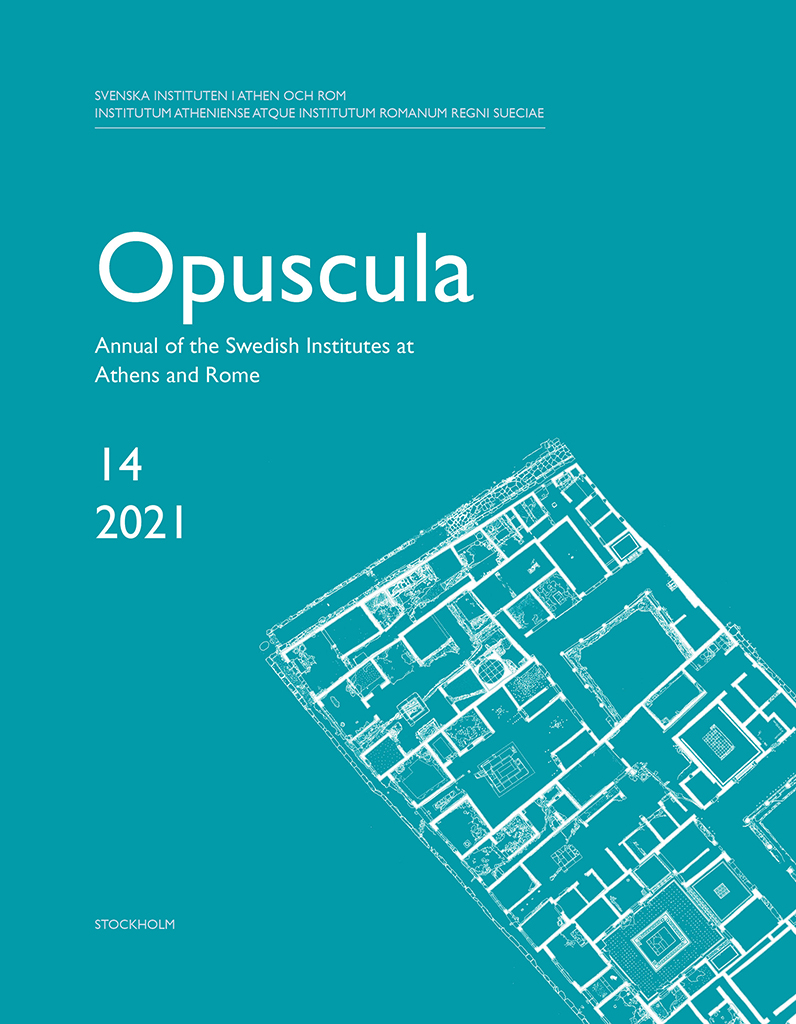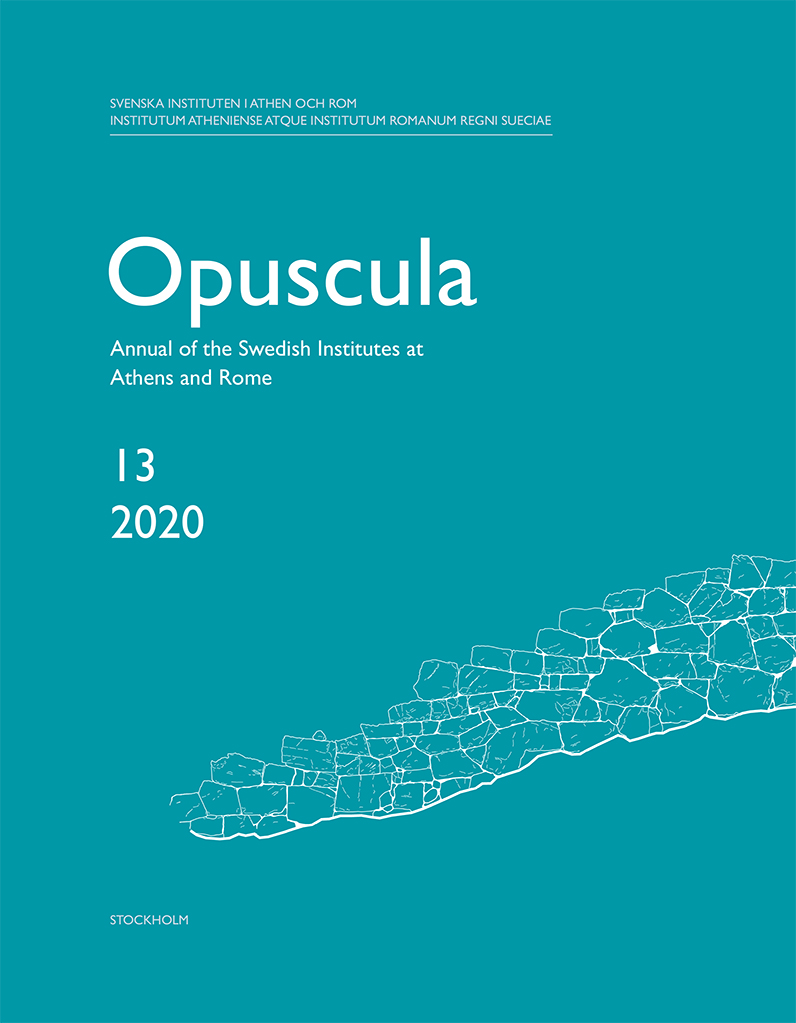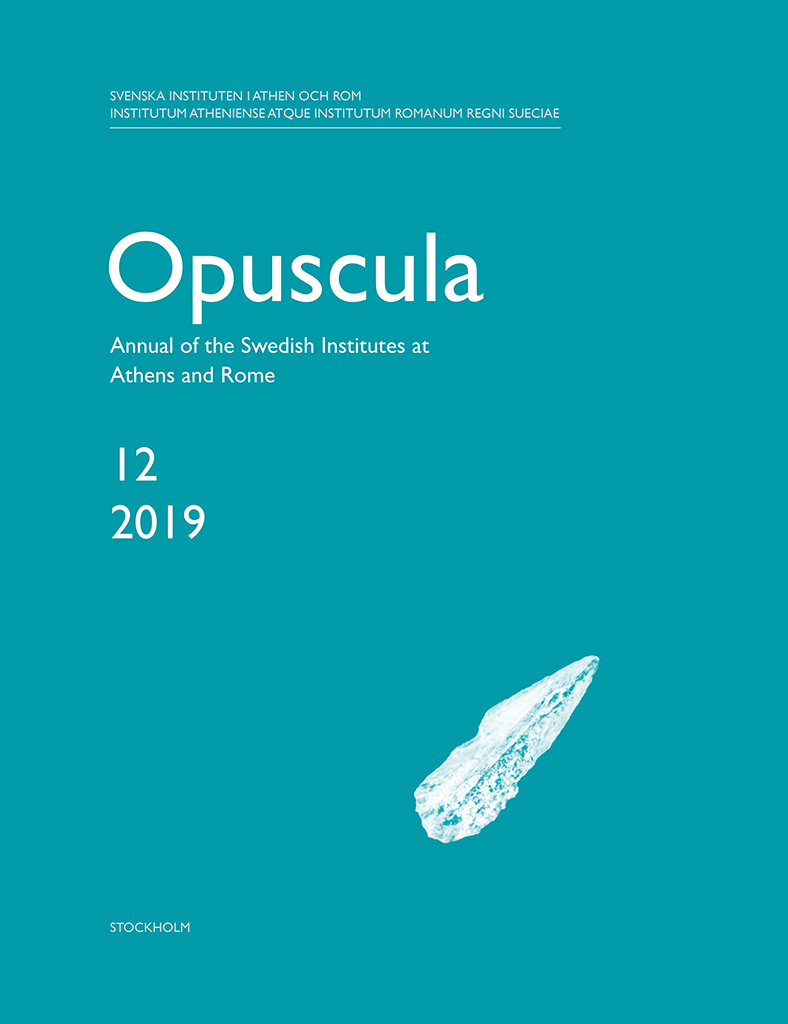Opuscula is published by the Swedish Institutes at Athens and Rome, with the aid of a grant from the Swedish Research Council. Distributed by Eddy.se AB. View journal at ERIH PLUS. All content available with open access. A bronze deposit excavated at Kalaureia in 2016. A statuette of the Herakles Chiaramonti type, a stand and a thymiaterion By Julia Habetzeder (Swedish Institute at Athens & Stockholm University) Abstract This article presents three bronzes found on the island of Poros in 2016, during excavations in Area L, the presumed area of Kalaureia’s ancient settlement, c. 200 m to the south of the Sanctuary of Poseidon. The deposit included: 1. A statuette of the Herakles Chiaramonti type, here suggested to have been produced during the 2nd or 1st century BC; 2. A stand which may have functioned as a thymiaterion (incense burner) or a lamp stand. Judging from close parallels the stand was most likely produced during the 5th or 4th century BC; 3. A high-stemmed dish, which is interpreted as a thymiaterion contemporary with the stand. The items are tentatively suggested to have been used together, perhaps in religious veneration of Herakles. The bronzes are suggested to have been deposited either for what was intended to be temporary…
Opuscula is published by the Swedish Institutes at Athens and Rome, with the aid of a grant from the Swedish Research Council. Distributed by Eddy.se AB. View journal at ERIH PLUS. All content available with open access. The Kalaureia Excavation Project. A preliminary report of the work carried out in Area L between 2015 and 2018 By Anton Bonnier (Uppsala University, Sweden), Therese Emanuelsson-Paulson (Stockholm University, Sweden), Dimitra Mylona (INSTAP Study Center for East Crete, Greece) & Arto Penttinen (Swedish Institute at Athens, Greece) Abstract The report presents a summary and preliminary discussion on the work carried out by the Swedish Institute at ancient Kalaureia between 2015 and 2018 in Area L. The excavations were focused on this area with the hopes of gaining a better understanding of the settlement which was situated south of the Sanctuary of Poseidon in antiquity. The excavations show that a large building was constructed probably around the middle of the 4th century BC in the western part of Area L. The full outline and functional use of the building has not yet been fully established but the building seems to have been in use in several subsequent phases. The excavated remains further suggest that…
Opuscula is published by the Swedish Institutes at Athens and Rome, with the aid of a grant from the Swedish Research Council. Distributed by Eddy.se AB. View journal at ERIH PLUS. All content available with open access. Religion and family politics in Hellenistic Kalaureia. Three new inscriptions from the sanctuary of Poseidon By Nikolaos Papazarkadas (University of California, Berkeley, USA) & Jenny Wallensten (Swedish Institute at Athens, Greece) Abstract This article presents three unpublished Hellenistic inscriptions from the sanctuary of Poseidon in Kalaureia (modern Poros): two found during archaeological excavations on the site and one recorded in a letter that was once part of Ioannis Kapodistrias’ official correspondence. All three inscriptions were dedicatory and carved on bases supporting portrait statues. Interestingly, they were offered to Poseidon by members of a single family already known from other documents in the Kalaureian epigraphic corpus. Remarkably, eight out of the 18 inscriptions discovered in Kalaureia make repeated references to men and women of this very family, which appears to have materially dominated Poseidon’s temenos and its environs during the 3rd and 2nd centuries BC through the careful placement of portraits of its members. Most of these statues were conspicuously placed by the entrance…
Opuscula is published by the Swedish Institutes at Athens and Rome, with the aid of a grant from the Swedish Research Council. Distributed by Eddy.se AB. View journal at ERIH PLUS. All content available with open access. Plants in the sanctuary. Charred seeds from Areas C and D at the Sanctuary of Poseidon at Kalaureia, Poros By Anaya Sarpaki (Independent scholar, Greece) Abstract Excavations at the Sanctuary of Poseidon at Kalaueria in the years 2003–2005 produced a small but quite interesting assemblage of charred seeds and fruits. Their analysis adds to a small existing body of such evidence and sheds light on several issues including aspects of the physical environment in the past, the agricultural economy in the area of the sanctuary, the role of plants in cult, and also the preparation and eating of plant foods and the possible alternative uses of them. The charred seeds that are presented here are part of a larger body of bioarchaeological remains that illuminate daily life in the sanctuary. Bibliographical information Anaya Sarpaki, ’Plants in the sanctuary. Charred seeds from Areas C and D at the Sanctuary of Poseidon at Kalaureia, Poros’, Opuscula. Annual of the Swedish Institutes at Athens and Rome…
Opuscula is published by the Swedish Institutes at Athens and Rome, with the aid of a grant from the Swedish Research Council. Distributed by Eddy.se AB. View journal at ERIH PLUS. All content available with open access. Trees and shrubs in the sanctuary. Wood charcoal analysis at the Sanctuary of Poseidon at Kalaureia, Poros By Maria Ntinou (Aristotle University of Thessaloniki, Greece) Abstract Wood charcoal analysis at the Sanctuary of Poseidon at Kalaureia, Poros aims to provide information on the vegetation of the area and its management and on the range of plants used in the activities taking place at the sanctuary. During the excavations of 2003–2005 in Areas D and C, systematic samples from fills and features from all the excavated strata were recovered and water flotation was used for the separation of wood charcoal from the sediment. Wood charcoal was found in two pits dated to the Early Iron Age, near the supposed altar of the Archaic period (Feature 05), in a deposit of the Hellenistic period (the “dining deposit”), in floor deposits (Early Iron Age and Late Classical/Early Hellenistic periods), and fills of different chrono-cultural periods (Archaic–Early Roman). All the taxa identified in the wood charcoal assemblages…
Opuscula is published by the Swedish Institutes at Athens and Rome, with the aid of a grant from the Swedish Research Council. Distributed by Eddy.se AB. View journal at ERIH PLUS. All content available with open access. Marine and terrestrial molluscs in the sanctuary. The molluscan remains from the 2003–2004 excavations in the Sanctuary of Poseidon at Kalaureia By George E. Syrides (Aristotle University of Thessaloniki, Greece) Abstract This paper presents the hand-collected molluscan remains that were recovered from the excavations in Areas C and D of the Sanctuary of Poseidon at Kalaureia, Poros, in the years 2003–2004. The paper aims at the presentation of the finds and at using the molluscan biological and ethological traits to provide insights into the possible capture methods and use. Land snails are also summarily presented. Bibliographical information George E. Syrides, ’Marine and terrestrial molluscs in the sanctuary. The molluscan remains from the 2003–2004 excavations in the Sanctuary of Poseidon at Kalaureia’, Opuscula. Annual of the Swedish Institutes at Athens and Rome (OpAthRom) 12, Stockholm 2019, 241–254. ISSN: 2000-0898. ISBN: 978-91-977799-1-3. https://doi.org/10.30549/opathrom-12-07 Bioarchaeological remains from the Sanctuary of Poseidon at Kalaureia The section on the bioarchaeological remains from the Sanctuary of Poseidon at Kalaureia,…
Opuscula is published by the Swedish Institutes at Athens and Rome, with the aid of a grant from the Swedish Research Council. Distributed by Eddy.se AB. View journal at ERIH PLUS. All content available with open access. Snakes and other microfaunal remains from the Sanctuary of Poseidon at Kalaureia By Petros Lymberakis (Natural History Museum of Crete, Greece) & Giorgos Iliopoulos (University of Patras, Greece) Abstract The microfaunal remains recovered at the Sanctuary of Poseidon at Kalaureia (Poros island, Greece) are abundant and varied. They belong to a number of different animal taxa, including snakes, frogs, lizards, and some micromammals. They have been found in several locations but the largest concentration originates in a closed Late Hellenistic/Early Roman deposit within a cistern (Feature 03). The snakes in this assemblage are numerous, belonging to terrestrial and aquatic species, and to both venomous and non-venomous varieties. Bones of some of them along with certain frog bones show traces of burning, which may suggest some type of manipulation before the deposition. The microfaunal remains from the Sanctuary of Poseidon at Kalaureia also strongly suggest that these types of animal were involved in ritual activities—dead or alive. Bibliographical information Petros Lymberakis & Giorgos Iliopoulos,…
Opuscula is published by the Swedish Institutes at Athens and Rome, with the aid of a grant from the Swedish Research Council. Distributed by Eddy.se AB. View journal at ERIH PLUS. All content available with open access. Animals in the sanctuary. Bird bones and eggshell By Dale Serjeantson (University of Southampton, United Kingdom) Abstract Excavations at the Sanctuary of Poseidon at Kalaureia and the application of a systematic soil sampling and water flotation programme led to the collection of a moderate amount for bird bones and eggshell fragments. Their dating in the first millennium BC and their association with cult renders them a significant addition to the extant bird remains record in Greece. In this paper the bird and egg remains are presented in detail by chronological phase and by feature, they are compared with other contemporary assemblages of bird remains, and some commentary is offered on their significance. Bibliographical information Dale Serjeantson, ’Animals in the sanctuary. Bird bones and eggshell’, Opuscula. Annual of the Swedish Institutes at Athens and Rome (OpAthRom) 12, Stockholm 2019, 223–231. ISSN: 2000-0898. ISBN: 978-91-977799-1-3. https://doi.org/10.30549/opathrom-12-05 Bioarchaeological remains from the Sanctuary of Poseidon at Kalaureia The section on the bioarchaeological remains from the Sanctuary of…
Opuscula is published by the Swedish Institutes at Athens and Rome, with the aid of a grant from the Swedish Research Council. Distributed by Eddy.se AB. View journal at ERIH PLUS. All content available with open access. Animals in the sanctuary. Mammal and fish bones from Areas D and C at the Sanctuary of Poseidon at Kalaureia. With an appendix by Adam Boethius By Dimitra Mylona (INSTAP Study Center for East Crete, Greece) Abstract During the excavations at the Sanctuary of Poseidon at Kalaureia an extensive archaeo-environmental programme was implemented, resulting in the collection and analysis of a wide range of animal remains. This paper presents the mammal and fish remains in detail and offers interpretations which take into account the archaeology of the site, other types of finds, as well as the discourse on animals in cult. The material is examined in terms of chronological phases and of particular features within them in an attempt, common in all types of analysis within the Kalaureia Excavation Program, to link the material remains to human actions, placing emphasis on the materiality of cult. The degree of analysis and interpretation detail varies among different occupational phases of the sanctuary, because of the…
Opuscula is published by the Swedish Institutes at Athens and Rome, with the aid of a grant from the Swedish Research Council. Distributed by Eddy.se AB. View journal at ERIH PLUS. All content available with open access. Physical environment and daily life in the Sanctuary of Poseidon at Kalaureia, Poros. The bioarchaeological remains By Arto Penttinen (Swedish Institute at Athens, Greece) & Dimitra Mylona (INSTAP Study Center for East Crete, Greece) Abstract The section below contains reports on bioarchaeological remains recovered in the excavations in Areas D and C in the Sanctuary of Poseidon at Kalaureia, Poros, between 2003 and 2005. The excavations were directed by the late Berit Wells within a research project named Physical Environment and Daily Life in the Sanctuary of Poseidon at Kalaureia (Poros). The main objective of the project was to study what changed and what remained constant over time in the everyday life and in both the built and physical environment in an important sanctuary of the ancient Greeks. The bioarchaeological remains, of a crucial importance for this type of study, were collected both by means of traditional archaeological excavation and by processing extensively collected soil samples. This text aims to providing the theoretical…




